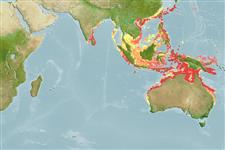Elasmobranchii (tubarões e raias) (sharks and rays) >
Rhinopristiformes (Shovelnose rays) >
Rhinidae (Wedgefishes)
Etymology: Rhynchobatus: Greek, rhingchos = snout + Greek, batis, -idos = a sting ray (Raja sp.) (Ref. 45335).
More on author: Whitley.
Environment: milieu / climate zone / depth range / distribution range
Ecologia
marinhas demersal; intervalo de profundidade 0 - 60 m (Ref. 106604). Subtropical; 30°N - 30°S, 30°E - 155°E (Ref. 114953)
Indo-West Pacific: Red Sea, Persian Gulf (Ref. 114953). Gulf of Thailand and the Philippines to Queensland, Australia. A similar and perhaps identical species occurs in the western Indian Ocean off Mozambique and in the Gulf of Aden and is probably sympatric with the true 'Rhynchobatus djiddensis' of the western Indian Ocean and the Red Sea. Distributional range probably wider than reported, but many nominal records of Rhynchobatus djiddensis from the western Pacific and southeastern Indian Ocean cannot be identified to species.
Comprimento de primeira maturação / Tamanho / Peso / Idade
Maturity: Lm ?, range 155 - ? cm
Max length : 124 cm TL macho/indeterminado; (Ref. 114953); 300.0 cm TL (female)
Inhabits inshore waters on the continental shelves (Ref. 9915). Demersal on soft bottoms and near coral reefs (Ref.58048). Female specimens may reach 300 cm in length in Thailand (Ref. 9915). Feeds on bottom crustaceans, mollusks (Ref. 9915) and bottom-dwelling fishes (Ref. 114953). Ovoviviparous (Ref. 50449). Caught commonly by demersal tangle net, and to a lesser extent by trawl and longline fisheries (Ref.58048). Marketed fresh; fins prized for the sharkfin trade (Ref. 9915).
Ciclo de vida ou comportamento de acasalamento
Maturidade | Reprodução | Desova | Ovos | Fecundidade | Larvas
Exhibit ovoviparity (aplacental viviparity), with embryos feeding initially on yolk, then receiving additional nourishment from the mother by indirect absorption of uterine fluid enriched with mucus, fat or protein through specialised structures (Ref. 50449).
Compagno, L.J.V. and P.R. Last, 1999. Rhinidae (=Rhynchobatidae). Wedgefishes. p. 1418-1422. In K.E. Carpenter and V. Niem (eds.) FAO identification guide for fishery purposes. The Living Marine Resources of the Western Central Pacific. FAO, Rome. (Ref. 9915)
Status na Lista Vermelha da UICN (Ref. 130435)
Ameaça para os humanos
Harmless
Uso pelos humanos
Pescarias: espécies comerciais
Mais informação
Idade/TamanhoCrescimentoPeso-comprimentoComprimento-comprimentoFrequências de comprimentoMorfometriaMorfologiaLarvasDinâmica larvalRecrutamentoAbundânciaBRUVS
ReferênciasAquaculturaPerfil para aquaculturaEstirpesGenéticaElectrophoresesHereditariedadeDoençasProcessamentoNutrientsConversão de massa
ColaboradoresFotosStamps, Coins Misc.SonsCiguateraVelocidadeTipo de nataçãoÁrea branquialOtólitosCérebrosVisão
Ferramentas
Relatórios especiais
Baixar XML
Fontes da internet
Estimates based on models
Preferred temperature (Ref.
123201): 23 - 28.4, mean 27.3 °C (based on 802 cells).
Índice de diversidade filogenética (Ref.
82804): PD
50 = 0.5049 [Uniqueness, from 0.5 = low to 2.0 = high].
Bayesian length-weight: a=0.00372 (0.00166 - 0.00830), b=3.11 (2.91 - 3.31), in cm total length, based on LWR estimates for this (Sub)family-body shape (Ref.
93245).
Nível Trófico (Ref.
69278): 3.5 ±0.50 se; based on food items.
Resiliência (Ref.
120179): Baixo, tempo mínimo de duplicação da população 4,5 - 14 anos (Fec assumed to be <100).
Fishing Vulnerability (Ref.
59153): Very high vulnerability (90 of 100).
Nutrients (Ref.
124155): Calcium = 24 [4, 109] mg/100g; Iron = 0.722 [0.186, 2.061] mg/100g; Protein = 19.3 [17.2, 21.3] %; Omega3 = 0.199 [0.088, 0.435] g/100g; Selenium = 23.8 [6.9, 67.8] μg/100g; VitaminA = 6.67 [2.30, 18.89] μg/100g; Zinc = 0.577 [0.286, 1.044] mg/100g (wet weight);
